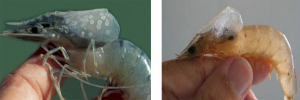1. Causes
* White spot disease on white leg shrimp and black tiger shrimp is usually caused by WSSV (White Spot Syndrome Virus) virus.
It severely affects the shrimp industry worldwide.
This disease causes a mortality rate of 90 to 100 percent after only 3 to 10 days of infection. It occurs mainly in the cold season when the temperature reduces below 32 degrees Celsius.

2. Symptoms
There are 3 cases of white spot formation on shrimp:
- Due to virus: Appearing white spots round and same. The center has round dots. Shrimp stopped eating, focused on edged ponds, and died in large numbers in 3 to 10 days.
- Due to pH higher than 8: Shrimp are active and normally eat, but die when molting.
- Due to bacteria: Shrimp are active and normally eat, but less die after molting.
3. Distinguish white spots disease caused by virus and bacteria
| White spot caused by virus | White spot caused by bacteria |
| Observation with the naked eye: easy to see white spots on shrimp shells | Hard to see. It can be seen on shrimp shells after molting |
| Observe under the microscope: white spots with a dark nucleus in the center | No nucleus, easy to change color
|
| Infection: shrimp die within 3 to 10 days | Shrimp die less and not simultaneously |
| PCR and histology test: positive result for WSSV | Negative result for WSSV |
4. Prevention measures
– Farming in the right season.
– Selecting quality and reputable hatchery with clear broodstock origin.
– Renovating ponds according to the technical process.
– Treating pathogens thoroughly before stocking shrimp.
– Stocking density is appropriate.
– Limiting intermediate organisms such as crabs and crustaceans with biosafety products.
– Periodically checking water and shrimp samples throughout the culture process.
– Strengthening resistance for shrimp with products such as Beta glucan, sorbitol, methionine, lysine, and VTM pp.
– Treating and supplying water during the farming process according to the water circulation process.
* Note: Do not use chemicals during the farming process. WSSV may attack when the shrimp body is damaged by parasites, bacteria, and fungi. In addition, this virus also harms when shrimp is stressed.
* WSSV is also considered an opportunistic pathogen.
By Master Huynh Duy Phong – Binh Minh Aquaculture Development Co., Ltd

 Tiếng Việt
Tiếng Việt 中文 (中国)
中文 (中国)